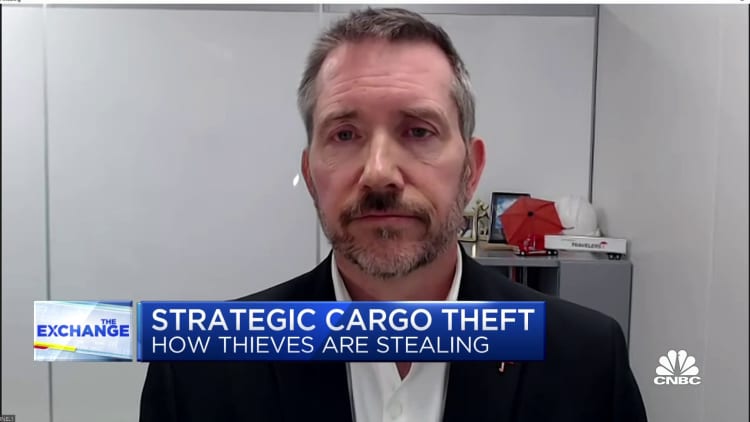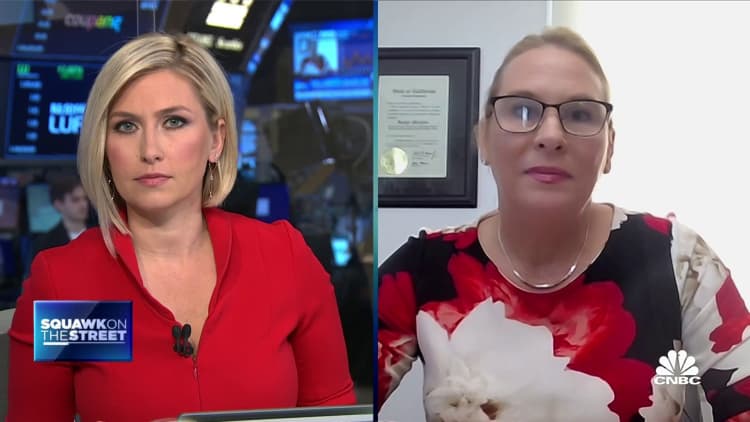Godong | Universal Images Group | Getty Images
Artificial intelligence is rapidly taking root in almost every field, and though the balance between theoretical potential and productivity will only become clear over time, one new test is taking place in the world of big-box retail, where AI is being used in tandem with anti-theft technology to fight against a growing wave of organized retail crime.
Large-scale theft of merchandise has been rising in the past few years, costing retailers billions in losses and endangering shoppers and employees, from the stores to distribution and in the supply chain.
Walmart, Target, Lowe’s, Kroger, Macy’s, CVS and other major retailers are teaming up with technology companies to develop and deploy next-generation video surveillance systems, facial-recognition cameras, license-plate and vehicle readers, autonomous security robots, radio-frequency identification (RFID) tags, smart case locks and predictive analytic software. While versions of this type of security tech have been in place for years, they’re now being superpowered by AI.
“We’re seeing a lot of tech vendors layering AI onto existing technologies,” said Christian Beckner, vice president of retail technology and cybersecurity for the National Federation of Retailers, a Washington, D.C.-based trade association. While AI is a powerful tool, Beckner said retailers have to be aware of the controversial issues that have been raised over the past year.
“Retailers need to use AI in a way that has appropriate guardrails, given the uncertainties of predictive outcomes of some AI tools,” he said. “If you’re using them to support loss-prevention activities, do it in a way that keeps humans in the loop before making any decisions that might have consequences for customers or employees.”
Catching retail thieves before they act
For retailers and loss-prevention experts, the primary goal of these technologies isn’t necessarily to catch thieves in the act, but rather to make committing their crimes less appealing — turning them away before they ever reach the door.
“The first thing we look at is, can we detect these people and identify them before there are victims?” said Dr. Read Hayes, director of the Loss Prevention Research Council, a think tank comprising researchers, retailers, technology companies, manufacturers and law enforcement professionals. “We’re trying to get the offender or crew to say, ‘Not here, not now, this doesn’t feel right.'”
Launched in 2000 with funding from Target and based at the University of Florida in Gainesville, the LPRC has tested hundreds of technologies in a simulation laboratory that recreates different retail environments, such as a checkout area in a big-box store, aisles in a home-improvement center or a shopping mall parking lot.
“We conduct large-scale experiments, much like randomized controlled clinical trials,” said Hayes, the son and grandson of physicians who sparked his interest in research.
Like high-tech scarecrows, preventive wizardry will ward off some criminals, but others fly right past it.
“Thieves want the easiest job possible,” said Dan Berthiaume, who covers technology for Chain Store Age. “If your store has some basic security protocols, they move on to a store that hasn’t been hardened.”
And many of the crimes that are being classified as organized retail theft are not taking place in stores, but at various points throughout the supply chain and distribution systems that require their own solutions.

To that point, total annual retail “shrink” — the reduction in physical inventory caused by theft or various other causes — was $94.5 billion in 2021, up from $90.8 billion in 2020, and nearly half was attributable to ORC, according to survey data from the NRF and research by the National Coalition of Law Enforcement.
In fact, the NRF reported, retailers on average saw a 26.5% increase in ORC incidents in 2021. Beyond the loss of goods, those crimes are increasingly dangerous. Eight in 10 of the 63 retailers surveyed said that the violence and aggression associated with ORC incidents had increased. In response, the NRF said, retailers are boosting their budgets for loss prevention and technology, and 52.4% are increasing expenditures specifically for capital and equipment.
Anti-theft locked beauty products with customer service button at Walgreens pharmacy, Queens, New York.
Ucg | Universal Images Group | Getty Images
Axis Communications, a Swedish company within the Canon Group, has been advancing internet-connected camera technology since the mid 1990s. It’s now harnessing AI to analyze metadata from video images captured by cameras installed outside and inside of retail environments. “The metadata of what the camera actually sees, like what our eyes transmit to our brain, is the intelligence behind the video,” said James Stark, segment development manager for Axis.
Stark referred to it as “scene intelligence.”
For instance, AI-assisted cameras mounted on towers overlooking a store parking lot can instantly analyze images of vehicles and individuals to help detect suspicious activity. That activates a loud warning over a speaker and strobe lights, hopefully scaring off would-be thieves. “You’re not going to stop all the bad actors,” Stark said, “but if you can detect and deter them, that’s a win.”
A barrage of anti-theft tech inside stores
If and when the bad guys do get inside stores, they’re often met with a barrage of technologies, many of them digitally connected, designed to thwart theft. Video surveillance has been around for decades, but today’s AI-enhanced camera systems monitor shelves, display cases, checkout lanes and other areas, amassing data that is analyzed using predictive software. If nefarious behavior is spotted — an individual’s hand is reaching for certain items, people are gathered in a particular area at a certain time, shoppers are looking in a distinct direction — store security is automatically alerted and a decision is made on whether to intercede.
Some retailers are using camera systems featuring facial recognition software to help identify criminals, despite legal and privacy concerns. There are no federal laws governing the technology, although some cities and states have bans or restrictions. Generally lax oversight has raised concerns among civil liberties and privacy advocates about bias in who is recognized and tracked and overuse of the technology.
David Johnston, vice president of asset protection and retail operations for the NRF, said that the association does not have an official position on the use of facial recognition, but acknowledged that some retailers are using and testing it. “It is a good investigative tool to help thwart the repeat offenders and identify those coming into your location,” Johnston said. As the technology evolves, and as shoppers’ expectations and regulators concerns are addressed, “we’ll get it aired out,” he said.

On the other hand, electronic article surveillance (EAS) systems are ubiquitous shoplifting deterrents in the retail world. Clothing shoppers are familiar with the hard plastic tags affixed to items, which if not removed or deactivated at checkout, will trigger an alarm when leaving the store.
Retailers are incorporating new types of radio-frequency identification (RFID) soft tags, such as a brand or care label embedded with a sensor that’s deactivated at checkout. Unlike hard tags, they’re often undetectable not only to shoppers, but thieves, too, making it easier for law enforcement to track stolen items, retrieve them and prosecute the perpetrators.
Sensormatic Solutions, a unit of Johnson Controls based in Boca Raton, Florida, is among numerous loss-prevention vendors providing EAS systems and RFID tags, as well as analytics software. “Analytics complement our EAS systems by delivering actionable insights to identify the root causes of shrink, including organized retail crime, and determine how to prevent it,” said Craig Szklany, vice president and general manager, loss prevention and liability for Sensormatic.
RFID tags have a dual purpose, Szklany said, serving as an inventory-management tool, capable of showing where merchandise is at all times, from manufacturing to shipping to warehouse to the retailer. “It’s not just about loss prevention,” he said, “but also retail and operational efficiency.”
RFID technology is incorporated in an in-store security program developed by Lowe’s, called Project Unlock, designed to prevent theft of power tools. During manufacturing, the products are embedded with an RFID chip, virtually invisible to customers, and set to inoperable. When the tool is purchased and scanned, it’s unlocked and ready to use. If it’s stolen or not unlocked, the product won’t work. In addition, both the power tool and the barcode on the box contain a unique serial number so the transaction is recorded on the blockchain, allowing vendors, resellers and law enforcement to verify that the item was legally purchased.
“Through partnering with the asset protection team and other groups within Lowe’s, we’re constantly innovating and leveraging technology to try to stay one step ahead, as best as we can, of bad actors, while still providing that great customer shopping experience,” said Cheryl Friedman, vice president of Lowe’s Innovation Labs, at a recent NRF conference.
Friedman said there is a flip side of hardening retail stores against ORC: ensuring that shoppers are not overly burdened by the increasing levels of security, whether it’s surveillance cameras, locked cases or RFID tags.
“Retailers are being forced almost by their shopper clientele, from a loyalty perspective, to remove friction from their environment,” Szklany said. “At the same time, when you remove the friction, you start to light the fire of theft and ORC.”
“We have to look at this at the root cause, why it’s happening,” said Johnston. “For the retailer and the consumer, it is more important to have that merchandise available. It’s a delicate balance, something the retailer doesn’t want, but the customers have to understand why it’s necessary.”
